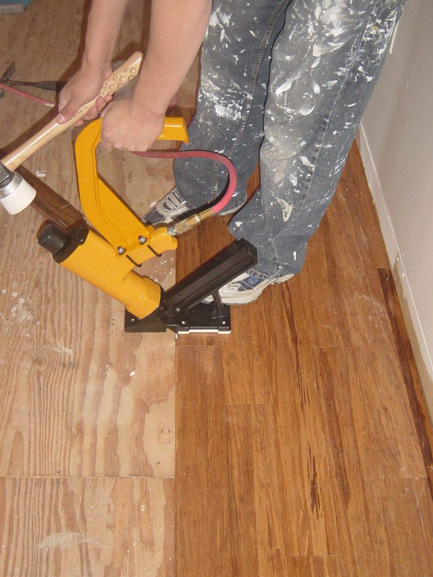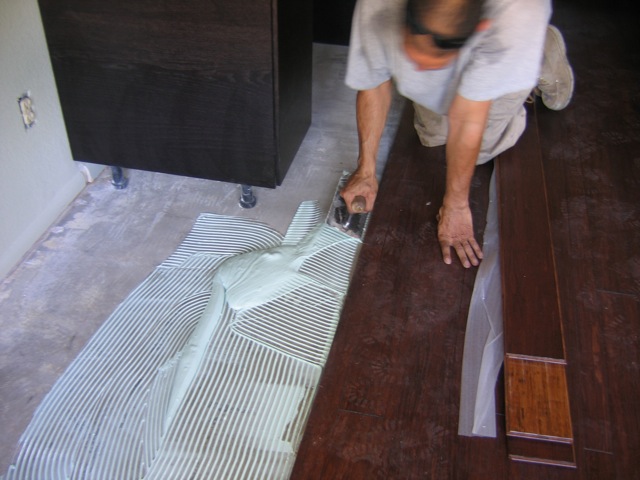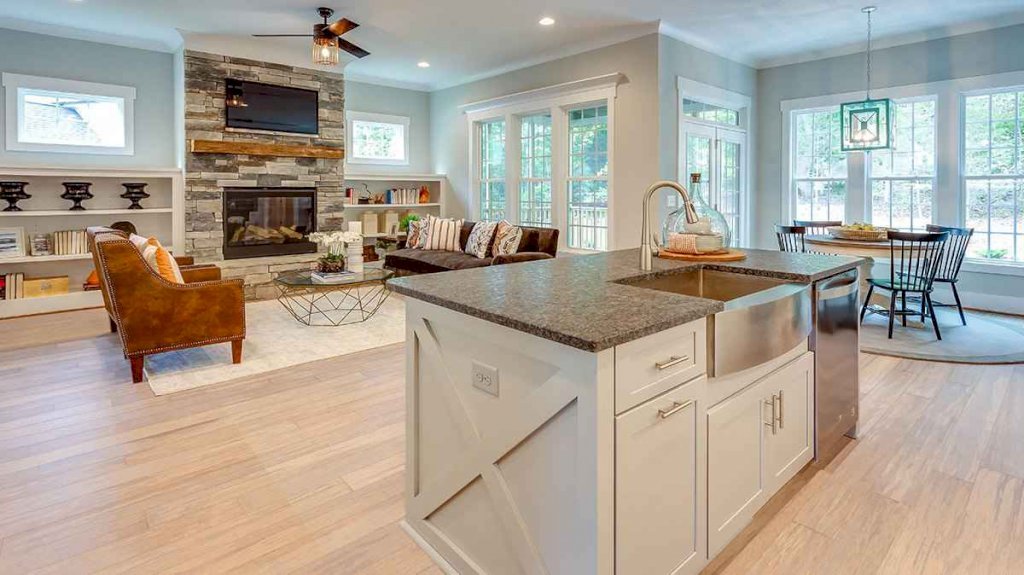Preparing to install a new floor can be a daunting task.
Maybe you’re planning on hiring some flooring contractors or you want to tackle the installation yourself. Either way, there are several different installation techniques to consider, including:
- the nail-down method
- the glue-down method
- the floating method
Floating floors are also known as click-lock flooring installations. They make for an easy installation without any complex equipment or confusing instructions.

However, while floating installations work great for bamboo flooring, they don’t work for every flooring material.
Continue reading to learn more about the different kinds of flooring installation methods. They each have their own pros and cons.
THE NAIL-DOWN METHOD

This is the most common way to install hardwood. Behind floating floors, it is the cheapest and fastest installation method. Approximately 70% of tongue and groove floors are nailed down using the “blind nailing” nail-down method, which hides the nail holes.
While this method is economical, one potential downside is that the nails can loosen due to seasonal expansion and contraction. This can cause floors to become creaky and an expansion gap to appear between planks.
Also, keep in mind that it may be necessary to manually nail down the first few rows of flooring. This is referred to as face nailing. It’s generally necessary because it can be hard to maneuver a floor nail gun close to your wall.
Due to its hardness, strand woven bamboo requires 18 gauge cleats and a high-quality pneumatic flooring nailer such as the Primatech Q550ALR. Using the wrong size cleats can cause dimples or ‘goosebumps’ in the flooring.
Before installation, you’ll want to purchase an underlayment such as 15 lb. felt paper or red rosin paper. These underlayments help reduce wood-on-wood squeaking.
Note that 15 lb felt paper and red rosin paper are NOT vapor barriers. If you need a vapor barrier*, the glue-down installation method should be used instead of nailing.
*A vapor barrier is necessary when installing floors over an unconditioned area (like a crawlspace) or a concrete slab.

THE GLUE-DOWN METHOD
A glue-down installation is the most expensive and labor-intensive of the three options. However, it’s also the most stable installation method.
This is because of glue elasticity, which allows the floors to expand and contract naturally with the seasons. If you purchase a high-quality adhesive like Ambient’s™ Ironwood All-In-One Wood Flooring Adhesive, you’ll get the added benefits of sound and moisture insulation.

Depending on your subfloor type (e.g., plywood), you may be able to use a cheaper wood flooring glue. However, if you’re installing the floors over a crawl space, you’ll need to use an all-in-one glue. This kind of glue contains a vapor barrier that seals concrete.
Make sure the adhesive you buy has an upper moisture limit of at least 10 lbs. And always test your concrete slab first for moisture to ensure it’s not excessively wet.
Note that it’s necessary to use the correct trowel with the correct glue.
Why? Use the wrong size trowel, and you won’t get the correct spread rate. This can compromise the new flooring’s ability to adhere to the subfloor.
Also, don’t forget to clean up glue spills before they dry on your flooring planks! Use a product like Bostik Ultimate Adhesive Remover Towels to avoid damaging your floor’s surface and finish.
How To Glue Down A Bamboo Floor from Ambient Bamboo on Vimeo.
THE FLOATING METHOD
The main advantage to a “click-lock” floating floor is its ease of installation and a shorter flooring installation time overall. A floating floor is also easier to repair in the event of a leak or issue that causes sectional damage.
Besides the click-lock version of flooring, a tongue and groove floor can also be floated. However, the latter is more time-consuming. This is because you must manually apply glue along the inside bottom groove along the entire length of each plank.

Before you jump on the floating floor bandwagon, note that there is one restriction that applies strictly to floating floors. (It applies to all floating wood floors, including bamboo). It has to do with humidity levels in your home and run distances on your floor.
Unless your home maintains a stable humidity level year-round (within a 20% range), you can only lay continuous runs of flooring for a certain distance – both in terms of length (longitudinal) and width (tangential).
CAVEAT: Do you live somewhere with stable humidity? Do you have an HVAC modulator that keeps your interior humidity within the 40%-60% range all year? If so, you do not have to follow these run limits.
However, if that is not the case, you must follow the run limits below:
- For an engineered floating floor, run limits are 25 feet wide and 45 feet long.
- For a solid (wood all the way through) floating floor**, run limits are 15 feet wide and 25 feet long.
**Ambient™ does NOT recommend nor advise installing solid bamboo flooring via the floating method.
It would help if you opted for a click-lock floor and a 3-in-1 underlayment for floating installations’ best results.

Bamboo Hardwood Flooring: Eco-friendly, Beautiful, and Affordable
Eco-friendly bamboo flooring is quickly becoming a top choice for those who love the look of solid hardwood flooring but want an option that’s better for the environment. Bamboo not only rivals the look of red oak hardwood, but it’s also a more sustainable, earth-friendly option. Why? Bamboo is a rapidly-growing grass that regrows every 5-7 years!
If you’re looking for an environmentally-friendly floor type, you’ll love Ambient™ bamboo flooring. Our flooring takes sustainability and non-toxicity to a whole new level with its flooring, glues, and finishes.
What do we mean by sustainable? Simply put, sustainable flooring fills our current needs without compromising the needs of people in the future. It balances these three key elements: economic, social, and environmental.
But that’s not the only reason for bamboo flooring’s growing popularity. Its strand-woven manufacturing process makes it rock-hard and durable, a definite plus in an active family home! That means it will need refinishing far less — if ever! — than typical engineered hardwood flooring will.
Of course, one also needs to think about the total cost of their flooring project. Fortunately, bamboo is generally more affordable than engineered wood flooring. However, its cost per square foot can vary, depending on the brand you choose, so do your due diligence.
Finally, bamboo floors are available in many stylish and modern finishes and colors!
Safe & Healthy Floors: Perfect for Any Home
Ambient™ is FloorScore® Certified, which means you don’t have to worry about dangerous off-gassing of toxic chemicals. FloorScore® is recognized by more than 19 leading environmental programs. The FloorScore® seal is your guarantee that a product has been independently tested and scored by SCS Global Services.
Plus, all of our adhesives and finishes are either ultra-low or zero-VOC. Your indoor air quality isn’t something you’ll have to compromise when installing an Ambient bamboo floor!
All Ambient floors are also Lacey Act Compliant. They have been legally sourced with minimal damage to the environment.
Add in one-stop shopping ease, great prices, honest reviews, and you’ve found the best place to buy your bamboo flooring. Shop our bamboo and eucalyptus floors today!
Last Update on 5/27/2023

About the Author
Jen is your go-to guru for crafting a cozy, green cocoon. 🪴 Her dive into sustainable building wasn’t just about saving the planet—it started as a mission to make family movie nights eco-friendly (and to ensure the popcorn was the only thing getting heated!). With a knack for breaking down the jargon, Jen turns eco-lingo into everyday language. Swing by the Green Living blog for a mix of earth-loving advice and home improvement hacks. Whether you’re just dipping your toes into green waters or you’ve been swimming in the deep end of DIY projects, Jen’s here to guide, giggle, and remind you that every eco-choice is a step towards a planet that thanks you… and maybe even sends a rainbow your way! 🌈


